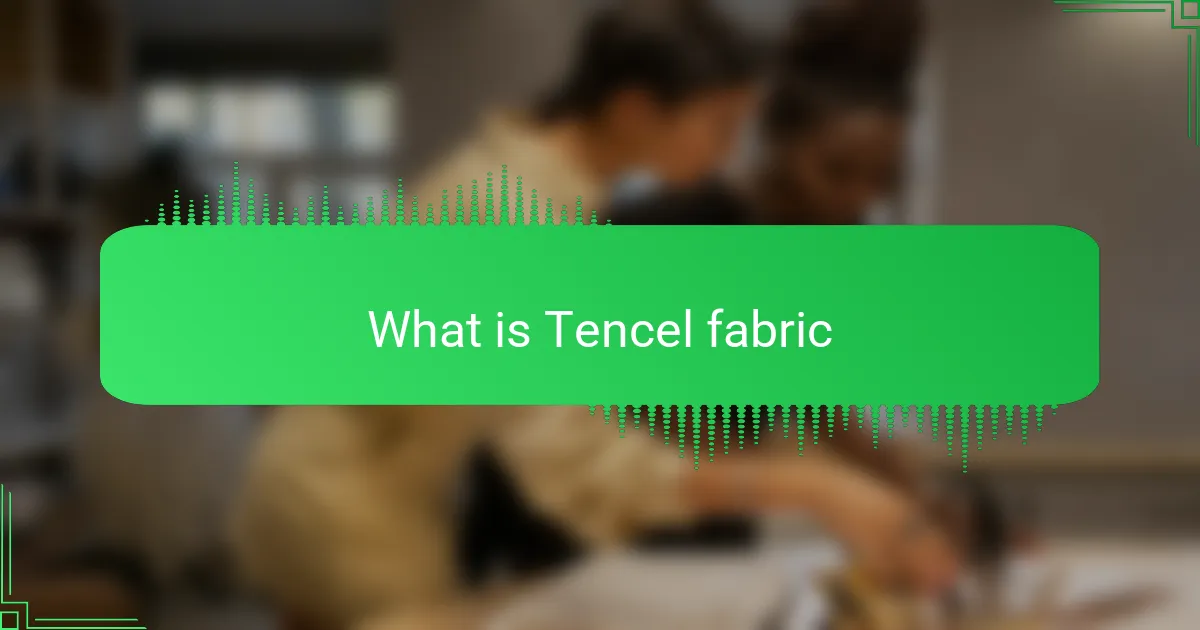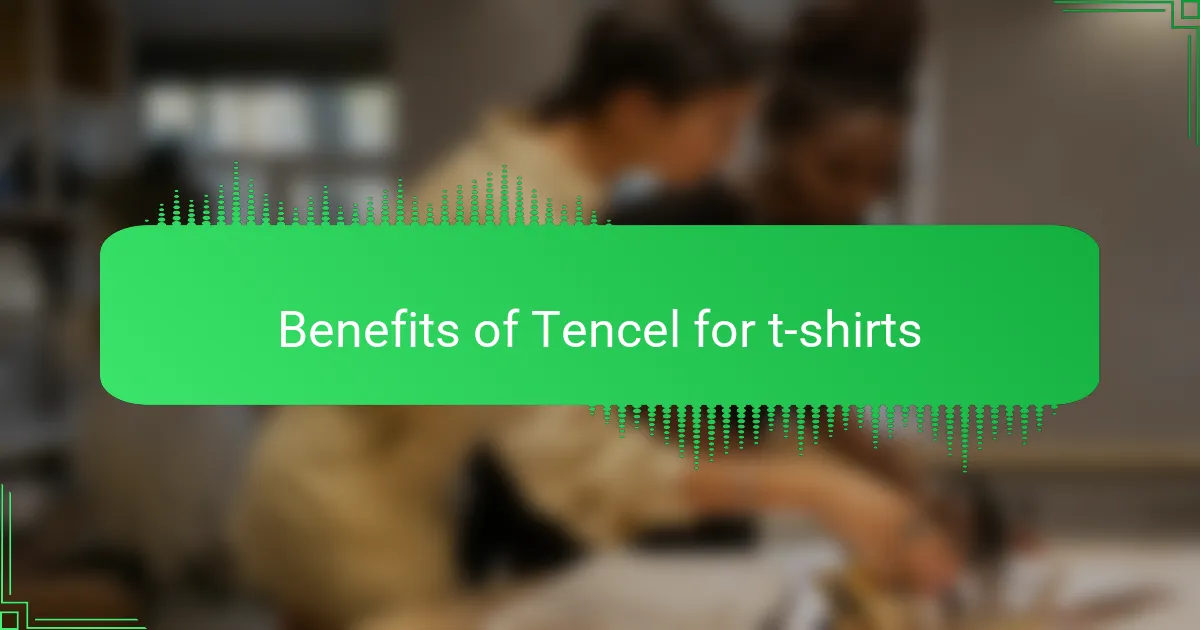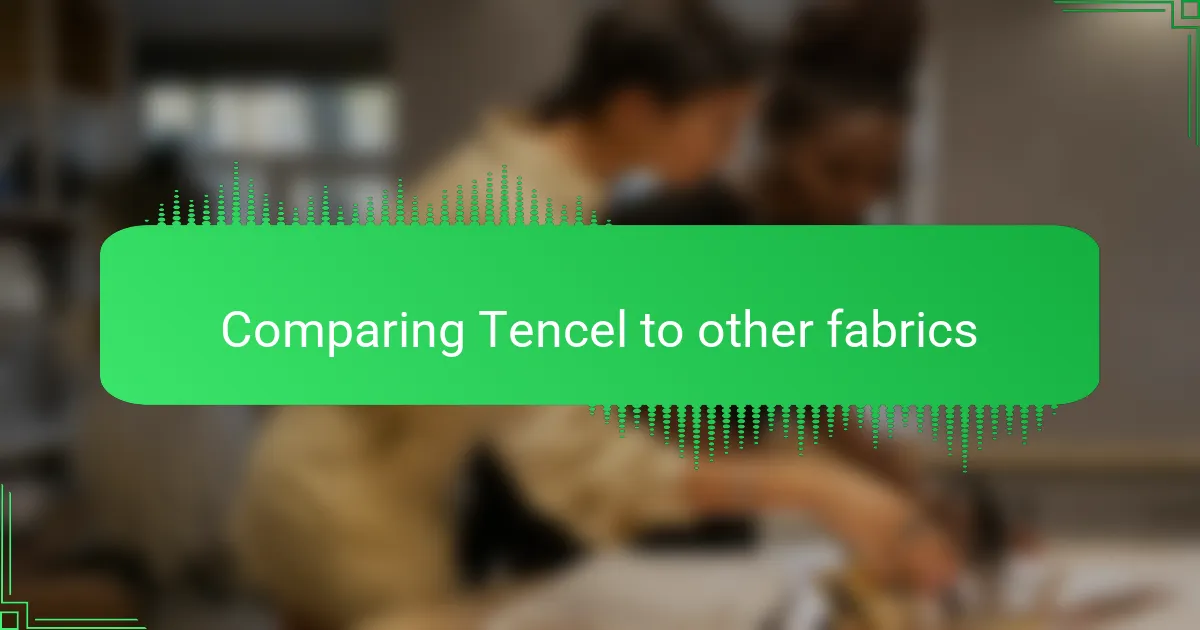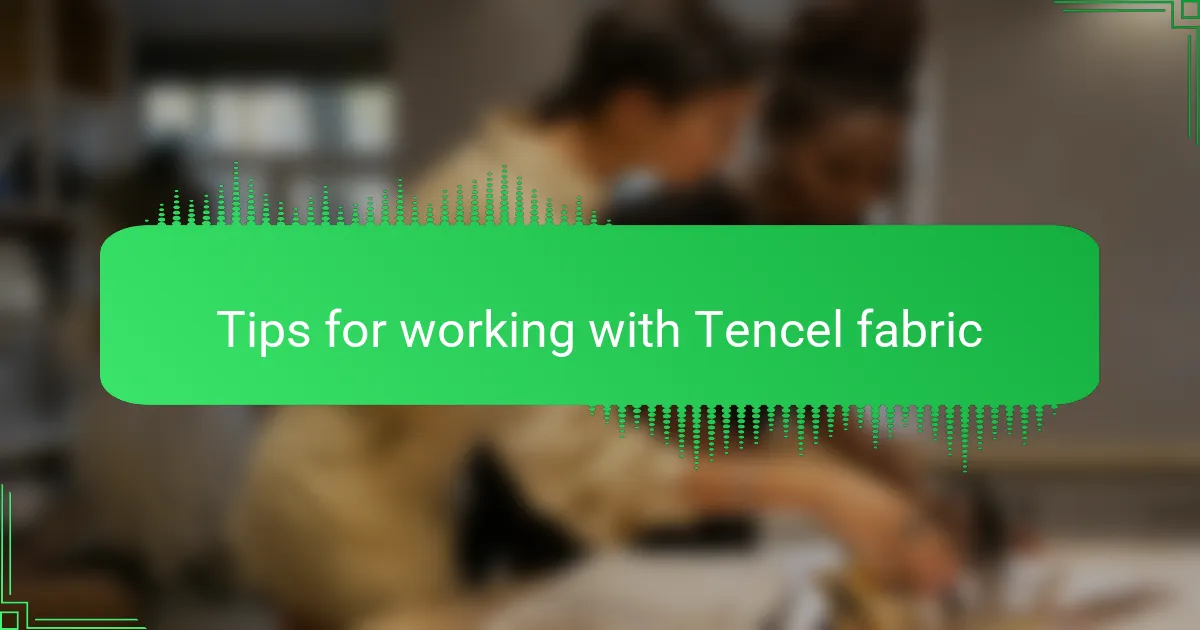Key takeaways
- Tencel fabric is made from sustainably sourced wood pulp, primarily from eucalyptus trees, offering a combination of softness and eco-friendliness.
- It excels in breathability and durability, maintaining its quality and comfort over time, making it ideal for t-shirts.
- Compared to cotton and polyester, Tencel is smoother, more breathable, and eco-friendlier, enhancing overall comfort and style.
- Key design considerations for Tencel include fabric softness, sustainability, durability, and moisture-wicking properties, catering to consumer needs for quality and comfort.

What is Tencel fabric
Tencel fabric is a type of fiber made from sustainably sourced wood pulp, often eucalyptus trees. From my experience, it feels incredibly soft and breathable, which makes it a fantastic choice for comfortable and eco-friendly t-shirts. What’s impressive is how it manages to combine luxury with sustainability — something that truly resonates with my values in design.
| Feature | Tencel |
|---|---|
| Source | Wood pulp from eucalyptus trees |
| Softness | Very soft and smooth to the touch |
| Breathability | Highly breathable, excellent for comfort |
| Sustainability | Environmentally friendly, biodegradable |
| Durability | Strong and resistant to wrinkles |

Benefits of Tencel for t-shirts
One of the biggest benefits I’ve noticed with Tencel t-shirts is how incredibly soft and smooth they feel against the skin. Have you ever worn a t-shirt and wished it didn’t irritate or cling? That’s exactly why I keep choosing Tencel—it feels like a second skin, making comfort a top priority in my designs.
What truly stands out to me is Tencel’s breathability. On warmer days, I’ve found Tencel t-shirts allow my skin to breathe naturally, unlike some synthetic fabrics that trap heat. This quality not only enhances comfort but also keeps the shirt feeling fresh longer, which is a game changer in daily wear.
Durability is another surprising advantage I appreciate. You might think something so soft could be fragile, but Tencel holds up well—it resists wrinkles and keeps its shape after many washes. For me, that means the t-shirts don’t just look good when I first get them; they maintain their quality over time, which feels like a smart investment in sustainable fashion.

Comparing Tencel to other fabrics
When comparing Tencel to other common fabrics like cotton and polyester, I’ve found Tencel stands out because of its softness and sustainability. Unlike cotton, which sometimes feels rough after multiple washes, Tencel maintains its smooth texture effortlessly. Polyester may be durable, but it doesn’t breathe well and often feels synthetic against the skin, which is a dealbreaker for me in t-shirt design.
| Fabric | Key Characteristics |
|---|---|
| Tencel | Soft, breathable, eco-friendly, resistant to wrinkles and shrinkage |
| Cotton | Natural, breathable, can feel rough over time, may shrink after washing |
| Polyester | Durable, moisture-wicking, less breathable, synthetic feel |

Factors I consider in design
When I design t-shirts using Tencel, comfort tops my list. I remember the first time I wore a Tencel tee—I was struck by how soft and breathable it felt against my skin. That experience instantly influenced how I approach fabric selection, making me prioritize materials that offer this level of comfort to my customers.
I also consider sustainability. Knowing that Tencel is made from responsibly sourced wood pulp aligns with my values and resonates with my audience. This connection makes the design process feel more meaningful, as I’m not just creating fashion, but supporting eco-friendly choices.
Here are the key factors I consider in my Tencel t-shirt designs:
– Fabric softness and breathability for all-day comfort
– Sustainable and eco-friendly sourcing to reduce environmental impact
– Durability to ensure the garment lasts through many wears and washes
– Draping quality that complements the design’s style and flow
– Moisture-wicking properties to keep wearers cool and fresh
– Versatility of color and print options on Tencel fabric

How I integrate Tencel into designs
I find integrating Tencel into my designs brings an unmatched softness that immediately resonates with comfort-seekers. Its natural sheen and smooth texture allow me to create t-shirts that feel as good as they look, making every piece special. Using Tencel also aligns with my commitment to sustainability, which adds an extra layer of satisfaction in my creative process.
| Feature | Tencel | Cotton |
|---|---|---|
| Softness | Exceptionally smooth and soft | Soft but can be coarser |
| Eco-friendliness | Produced from sustainably sourced wood | Requires significant water and pesticides |
| Durability | Strong and long-lasting | Durable but can shrink |
| Moisture Management | Highly absorbent and breathable | Absorbent but slower to dry |
| Appearance | Natural sheen and smooth finish | Matte and textured |

Tips for working with Tencel fabric
I’ve found that handling Tencel requires a bit more care than cotton, but the payoff is worth it. Its smooth texture means it’s less prone to pilling, yet it can be slippery when cutting, so I always use sharp scissors and pin the fabric firmly. Washing Tencel in cold water and air drying helps preserve its softness and shape, which I’ve seen make my designs feel consistently fresh and comfortable.
| Tip | Reason |
|---|---|
| Use sharp scissors and pin fabric securely | Prevents slipping due to Tencel’s smooth, silky surface |
| Wash in cold water | Preserves fabric strength and vibrant color |
| Air dry instead of machine drying | Maintains softness and prevents shrinking |

Final thoughts on choosing Tencel
Choosing Tencel for my designs always feels like the right balance between luxury and responsibility. Have you ever wondered if a fabric could truly offer both softness and sustainability? In my experience, Tencel checks those boxes effortlessly, making it a fabric I trust to uphold both comfort and eco-conscious values.
I remember the first time I noticed how Tencel held its shape and resisted wrinkles even after many wears—it gave me confidence that my designs wouldn’t just look good initially but continue to feel great over time. This durability means more than just longevity; it reflects a thoughtful investment in quality that customers appreciate as much as I do.
Ultimately, picking Tencel is about more than fabric choice—it’s about creating pieces that feel good in every sense. When I design with Tencel, I’m not just making t-shirts; I’m crafting experiences that marry softness, style, and sustainability. Isn’t that what great design is all about?
